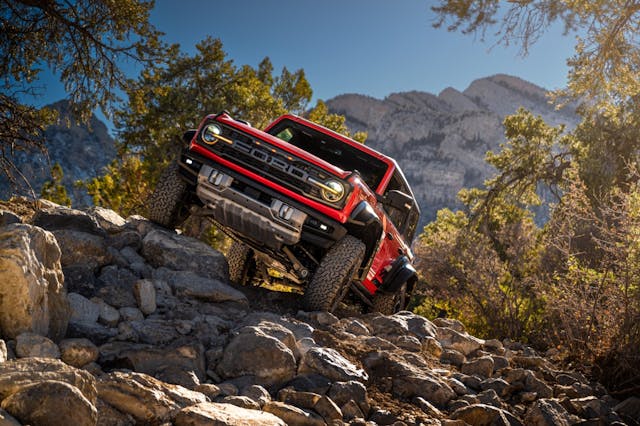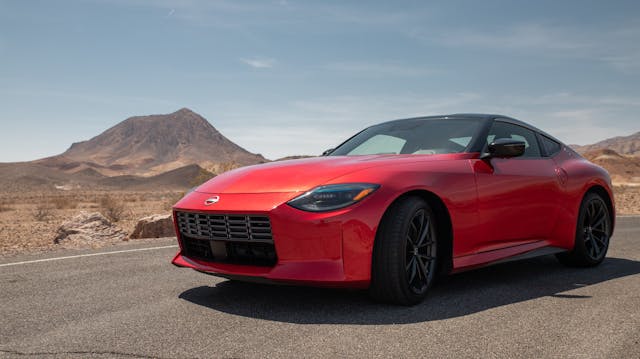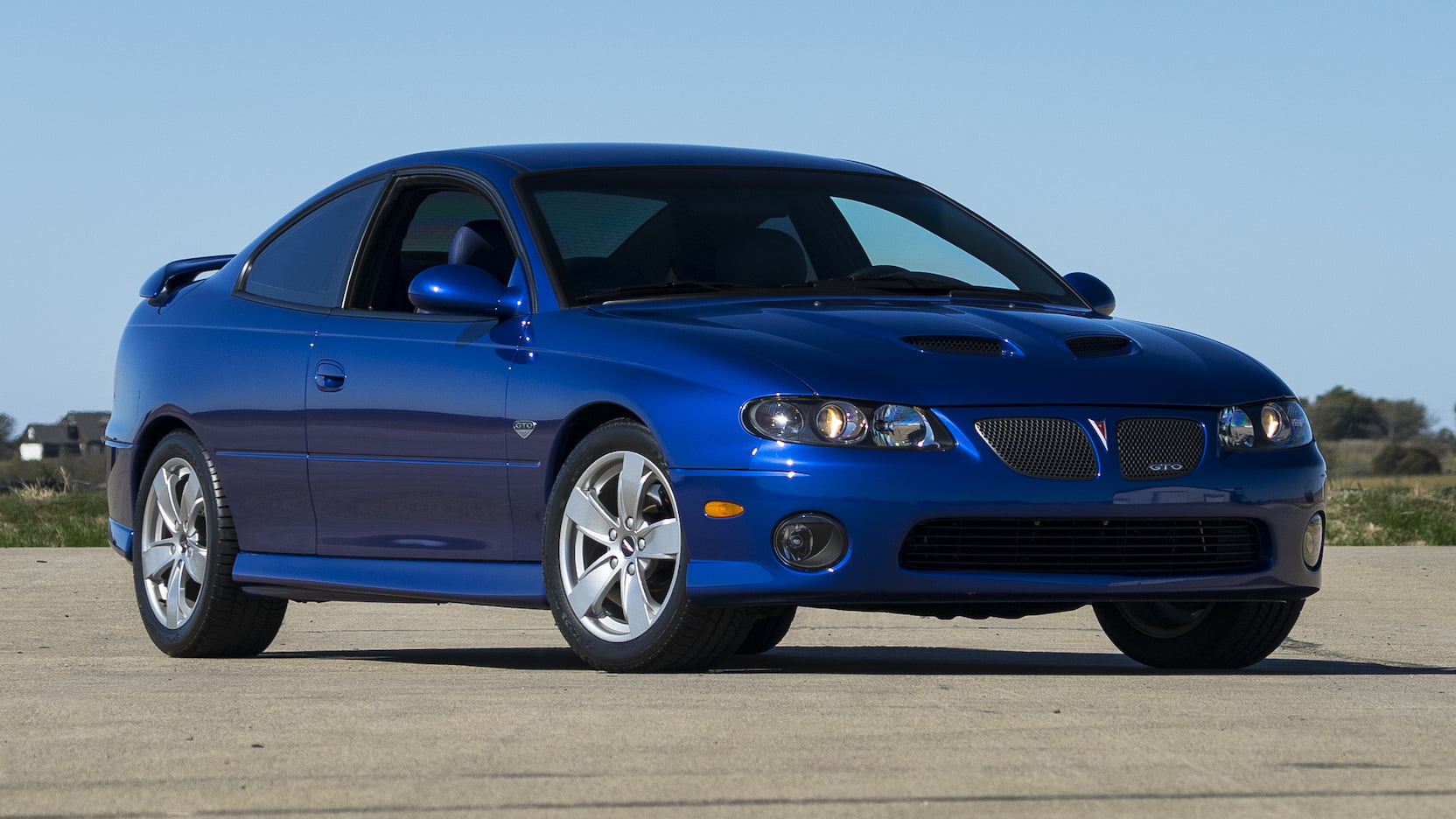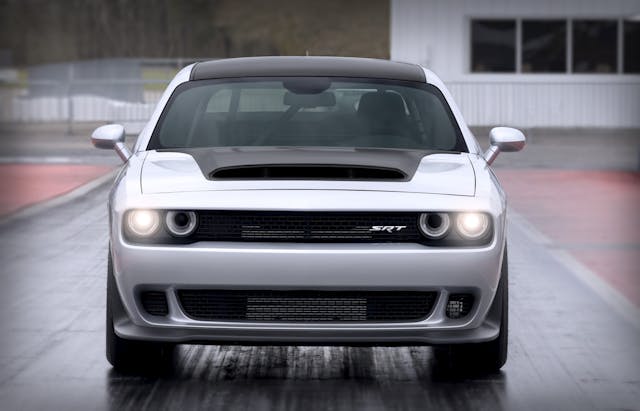17 cars that were resurrected, for better or for worse
This story originally appeared on Hagerty Media in October of 2019. It is reproduced here with minor changes for timeliness.
Over the last 20 years, the auto industry has gotten into the habit of digging up its cold, dead nameplates and reintroducing modern versions of cars it killed off long ago, probably for reasons long forgotten. It seems to have begun with the reimagination of the Volkswagen Beetle back in 1998 and the reinvention of Mini by BMW in 2000.
Recent efforts have been a mixed bag. On the sports car side of things, we got the Toyota Supra and a new Nissan Z. SUVs were also a popular category, from the Jeep Gladiator to the Ford Bronco to the Land Rover Defender. Some popular models came back a little different than what we like to remember. Chevy exhumed Blazer for a sporty-looking crossover, not the Wrangler fighter we were hoping for. The Grand Wagoneer reemerged as a six-figure behemoth clearly aimed at blacktop, not backroads.
and the fact that Jeep is also working on a new Grand Wagoneer.
Here are 17 classic nameplates that have come back from the dead. There are others, but these are some of the best, along with a couple of losers.
Acura NSX
20180911153111)
Honda stunned the world in 1991 when it launched the first-generation NSX supercar. Sold in America as the Acura NSX, the mid-engine machine was a technological tour de force, with an aluminum structure and body, a 270-horsepower all-aluminum DOHC VTEC V-6 with an 8500 rpm redline, and titanium connecting rods. It was as fast as a Ferrari and as civilized as an Accord. Production lasted until 2005. In 2017, the Acura NSX returned as an all-wheel-drive hybrid. Power comes from a twin-turbo V-6 combined with three electric motors and a battery pack to produce a total of 573 hp. Unfortunately, sales have been slow, and through the first seven months of this year, Acura has sold just 161 NSXs.
Chevy Blazer

From 1969–93, Chevy’s K5 Blazer was a brutish but civilized full-size SUV based on the underpinnings of the brand’s popular pickup. In 1994, the truck grew into a four-door and it was renamed the Tahoe. Chevy also used the Blazer name on the smaller S-10 Blazer, which was based on the S-10 compact pickup. That vehicle morphed into the Trailblazer in 2002, which was laid to rest with the introduction of the Traverse in 2009. And now the Blazer is back for 2019, only it has no connection to the original K5. Instead, it has become a car-based crossover with about as much off-road capability as a Camaro. It even shares some of the Camaro’s design inside and out. Although all-wheel drive is available, Chevy calls the new Blazer “street-inspired.” We call it a missed opportunity.
Chevy Camaro

In 2002, after 35 years of continuous production and four generations, Chevy built its last Camaro. Or so we thought. It came back in 2010, emulating the design of the muscle cars first generation, produced from 1967–69. It was a response to the new retro design of the 2005 Ford Mustang and the recreation of the Dodge Challenger, which launched in 2008. Chevy even dug through its archives and relaunched many classic Camaro models, including the RS, SS, Z/28 and COPO. Today, the new mid-engine C8 Corvette is grabbing all the headlines, but the Camaro’s sixth generation, launched in 2016, remains in production.
Dodge Challenger

Let’s forget that Dodge sold a front-wheel-drive version of the Challenger, based on the Mitsubishi Galant, from 1978–83. The original Challenger, sold from 1970–74, is the one that really matters. It shared its platform with the Plymouth Barracuda, and its R/T models were powered by legendary V-8s, including the 440 Six-Pack and the 426 Hemi. Dodge launched a modern interpretation of that iconic muscle machine in 2008, with the R/T returning in 2009. Today’s Challenger not only remains in production, but its supercharged Hellcat and Demon models reign supreme as the quickest and most powerful American muscle cars ever.
Dodge Charger
20190814174802)
First introduced in 1966, the Dodge Charger remained in continuous production through 1978 and four generations. A front-wheel-drive K-car-based version appeared from 1982–87, highlighted by the turbocharged Shelby model, but then the Charger went away for nearly two decades. It was reinvented in 2006 as a rear-wheel drive four-door sedan, using the platform that would also be used for the Challenger two years later. The extra doors were quite controversial, but there was an R/T model with a Hemi V-8 under the hood. Now in its seventh generation, the Charger shares its supercharged Hellcat Hemi with over 700 hp with the Challenger, making it the most powerful American sedan in history.
Fiat 500

Iconically cute, the original Fiat 500, or Cinquecento, was built from 1957–75. It was a tiny, economical, and affordable city car with an air-cooled engine mounted in the back, just like the Volkswagen Beetle. Nearly 4,000,000 were produced, but the 500 was never sold in the United States. With the successful return of the Beetle and the Mini, Fiat went back in time and relaunched a modern version of the 500 in 2007. Now front-engined with front-wheel drive, it was significantly larger than its namesake, but it captured the look of the original perfectly and became very popular in Europe. Fiat returned to the U.S. market in 2011, bringing the 500 to America for the first time. Today, it offers a turbocharged Abarth model, reintroducing another classic nameplate, as well as an electric version. However, it will be discontinued again after this model year.
Ford Bronco

First-generation Ford Broncos, built from 1966–77, have been pegging the popularity meter with collectors for nearly a decade, and consequently their values continue to rise. In 1978, the two-door SUV went full-size to better battle Chevy’s Blazer, and it remained in that configuration for five generations, with production ending in 1996. Ford also produced the smaller Bronco II from 1984–90, and although it was successful, it never really captured the magic of the original. Ford unveiled the Bronco Concept 14 years later at the Detroit Auto Show, and it has been teasing us with the SUV’s return ever since. Well, it’s finally about to happen. The 2020 Ford Bronco will be based on the Ford Ranger pickup’s ladder frame and is promised to offer true off-road capability. We hope it’s a true competitor for the Jeep Wrangler.
Ford Shelby Mustang GT350/GT500
20190515130127)
Ford turned back the clock in 2007, reintroducing the Shelby GT500 Mustang, a model that hadn’t seen production since 1970. The new version was supercharged and packing 500 hp, making it the most powerful factory Mustang ever. There have been a couple of iterations since; the most recent was the 2013–14 model with 662 hp. Well, here comes another. The 2020 Shelby GT500 will be packing a 760-hp supercharged 5.2-liter V-8 and a dual-clutch automatic gearbox.
Ford let the Shelby GT350 name lie dormant quite a bit longer. That model was originally sold from 1965–70 only to finally be reintroduced in 2016. It remains in production today with a 526-hp flat-crank 5.2-liter V-8 and a six-speed manual.
Ford Thunderbird
20190517172206)
Ford’s original retro redo was actually the 11th generation of its Thunderbird, which was sold from 2002–05. It was the first T-Bird in five years and it featured a modern take on the model’s original design, which had debuted in 1955. It was a two-seater for the first time since 1957 and its taillights emulated the look used by the model’s third generation, sold from 1961–63. Ford even brought back the iconic porthole hardtop used on 1956 and ’57 models. Still rear-wheel drive, the new Bird shared its platform with the Lincoln LS and Jaguar S-Type sedans. Ford owned Jaguar at the time and also used its 3.9-liter 252-hp V-8 in the T-Bird. Unfortunately, the new T-Bird’s modern-style interior, which was also shared with the Lincoln, felt disconnected to the convertible’s exterior design and the car wasn’t successful enough to warrant a successor.
Jeep Gladiator
20190329195902)
Many forget that Jeep has a solid legacy of successful pickups, and from 1962–71 it offered the Gladiator, which shared its frame and front suspension with the Wagoneer. The Gladiator name was ditched after 1971, but Jeep continued to produce pickups until 1988. The Gladiator Concept, a Wrangler-based pickup, made its debut 16 years later at the Chicago Auto Show, and the wait was on. Finally, it’s a reality. The 2020 Jeep Gladiator is now on the street (or is it the trail?) and it’s a sensation. It’s the first four-door pickup ever offered by Jeep, and the first convertible. It’s V-6-powered and there’s a Rubicon version with a lifted suspension, larger tires, and front and rear locking differentials.
Land Rover Defender

With lineage back to the original Land Rover launched over 70 years ago, the Defender name was first glued to the back of the 90 and 110 models in the 1980s. Sales began in the United States in 1993 and only lasted four years, but Defenders, in both the 90-inch and 110-inch wheelbases, have become modern classics and command ever-increasing values. Sales continued in other parts of the world, but production of the rugged SUV finally ended in 2016. Four years later, the Defender is back. At launch, the Defender 110 will have an optional third row seat and a shorter wheelbase Defender 90 will be added soon after. Under the hood will be a 300-hp 2.0-liter turbocharged four-cylinder or a 400-hp 3.0-liter V-6. Prices will start just over $50,000.
Nissan GT-R
20190415183105)
It has been 11 years since Nissan brought back its high-performance icon, the GT-R. The front-engine, all-wheel drive, turbocharged coupe was the first since 2002, and it was the first GT-R ever sold in America. The nameplate, originally introduced in 1969, dates back five generations of the Nissan Skyline. Initially it only lasted until 1973, only to be reintroduced in 1989. And then the legend of the GT-R truly began with its next three all-wheel drive generations (R32, R33, R34), powered by the RB26DETT twin-turbocharged inline six-cylinder. Paul Walker drove an R34 in a few of the Fast and Furious movies, which only intensified the GT-R’s global popularity. Today, the GT-R Nismo is packing 600 hp.
Nissan Z

Nissan’s Z has had its ups and downs over the last 50 years. First introduced as the Datsun 240Z in 1970, it landed in North America as the Nissan 300ZX. Production lasted until 2000, along with sales in Japan, and then the Z took a three-year hiatus. The all-new 350Z was introduced in 2003, but the twin-turbo and 2+2 models were history. All Zs were now naturally aspirated with a 3.5-liter DOHC V-6, and they were all two-seaters. In 2009, the car received another redo and a larger 3.7-liter engine. The 370Z remains in production today, basically unchanged for the last 10 years.
Maserati Ghibli

A rival to the Ferrari Daytona, the original Maserati Ghibli was a sexy V-8-powered front-engine sports car. Designed by Giorgetto Giugiaro at Ghia, who went on to design the VW Golf, DeLorean, and Lotus Esprit, it featured pop-up headlamps, a 2+2 coupe and two-seat Spyder body styles. Production lasted from 1967–73. The name, which represents a wind in the Libyan desert, went dormant until the 1990s. Based on the Biturbo, the second-generation Ghibli, lasted from 1992–98. In 2014, Maserati brought the Ghibli back, this time as a turbo V-6-powered luxury sedan smaller than its Quattroporte. It remains in production today, essentially unchanged over the last half decade, but there’s a new twist on the horizon.
Pontiac GTO

Few cars have had an impact on the market like the original 1964 GTO. Created by Pontiac’s chief engineer John DeLorean and his team, and brilliantly marketed by Jim Wangers, it single-handedly launched the original muscle car era. That era was short lived, however, and despite a few redesigns and four generations, GTO production would last only a decade. By the early 2000s, Pontiac was selling Azteks, and the brand was on its last legs. Even the Firebird had been killed off in 2002. In a last-gasp attempt to capture some of its old glory, in 2004, Pontiac threw GTO badges on the LS-powered, rear-wheel drive Holden Monaro from Australia and crossed its fingers. It didn’t really work. Sales lasted just three years and Pontiac was laid to rest in 2010.
Toyota Supra

Originally, the Supra was a more powerful and sportier version of the Celica. Always rear-wheel drive, it debuted in 1978 and lived successfully through two generations. Then in 1987, it became its own model, and for the first time Toyota added a turbocharger. The Supra Turbo was packing a 231-hp 3.0-liter inline-six and sales lasted until 1992. The following year, Toyota created a legend, the fourth-gen Supra, powered by its 2JZ inline-six. Both naturally aspirated and twin-turbo versions were available, with the boosted version packing over 300 hp. Tuners got to work, and eventually 1000-hp MKIV Supras with stock engine blocks weren’t hard to find. Unfortunately, sales in America lasted only five years. And now the Supra is back. Toyota has partnered with BMW to create the modern version, a two-seat coupe powered by BMW’s twin-turbo 3.0-liter inline-six rated at 335 hp. It’s a mechanical twin to the new BMW Z4 Roadster, and it’s one of the most anticipated new cars this year.
Volkswagen Beetle
20180404162504)
After more than 20 years and two generations, Volkswagen has discontinued its modern interpretation of the Beetle. This is, of course, the second time the Bug has gone bye-bye. The original Beetle, designed by Ferdinand Porsche in the 1930s, remained in production somewhere in the world from 1938–2003. Over 21 million were built, all rear-engined, all air-cooled. Sales of the original ended in the United States in 1979. The New Beetle was introduced 19 years later, based on the front-engine, front-wheel drive underpinnings of the VW Golf. It was successful enough to warrant a successor in 2012. The flower vase on the dash was gone, but the spirit was still there. The Final Edition, a trim level with the turbocharged 2.0-liter engine and diamond-stitched leather seats, is available now.
***
Check out the Hagerty Media homepage so you don’t miss a single story, or better yet, bookmark it. To get our best stories delivered right to your inbox, subscribe to our newsletters.



I get WHY the auto manufacturers resurrect name plates. When they are well done (Challenger, Mustang, VW Bug and a few others) it’s great. Visually we connect the vehicle to its glorious past. But when it is just an old name plate that they slap on a new vehicle (Blazer, Gladiator, Pontiac GTO, and possibly Camaro) that is lazy marketing.Tell me, how exactly does the wishy-washy Blazer of today relate to the iconic Blazers of yesteryear? (Hint: it has the same name. Period). If the new vehicle is really great, launch it as such as a new vehicle. Too often, the Manufacturers (I’m looking at you GM, especially) don’t have a great product and done want to risk launching a brand new nameplate
I remember when the “NEW” gto dropped. I couldn’t believe it. I’d argue that my 2dr Grand Prix gtp with some tasteful mods was a better looking car than the gto. I had true duals but they exited on the one side, which was all wrong. I think it was something to do with the gas tank on the 04 model, Thankfully they changed that in 05 but the car was soon dead after 06 anyways.
I like the new Javelin – the one in use in Ukraine!
I’m waiting for the reintroduction of the ‘Dodge’ Barracuda.
I would be happy to drive and/or own any of the vehicles on this list. Would I buy one? Probably not.
In my humble opinion the only decent resurrection that is currently on the market is the Pursang Bugatti. If I had any spare change, there would be one in my fleet.
I would be happy to own or drive any of the vehicles on this list. Would I buy one? Probably not. The only true resurrection that is currently available is the PurSang Bugatti. If I had any spare change, there would be one in my fleet and it would always be full of gas and close to the door.
Geez Louise! Why am l the only one to mention the Avanti?
The last iteration of the car and post-Studebaker companies made their “resurrection” out of a Mustang from 2001 to 2007, besting the life of the Thunderbird and the GTO in this article!
Amen to the Avanti. The article was obviously written by some newby. The DeLorean was also missed.
Easy, I like most o these comebacks but really would only want to own and drive the T-Bird and only if it got a major reliability upgrade.
Hate every Mopar 4 door tries to look 2 door thing they did. Those things were crimes against humanity.
Someone did mention the Ranger, but you can go back farther all the way to the 70’s (maybe the 60’s?) when the Ranger was a trim package on the F-100 and F-150 series trucks.
In my mind’s eye, I seen to remember most Rangers were either brown or burnt orange, and had these of star pattern hub caps.
I could be mistaken on some of the details as I was only a young lad.
Yes Ranger was a full size trim package. At least Silverado became the name on the same sized thing…
Similar to GM “graduating” model lines so your top of the line Bel Air (Impala, etc.) is eventually a base model. People buying that in the middle of the run get the fumes of the prestige ad campaign of the prior.
Resurrected doesn’t bother me so much, continuing as something else is more annoying. I get the GM downsizing in 77/78. But calling the new models the same thing was a bit sneaky. More so when this happened again in the 90s with the Caprice Classic/Impala.
Malibu has to be one of the worst rebirths though, though I may be distorted with my family having owned a 70 Malibu convertible in the 90s. Zero translation to the modern Malibus.
New Gladiator is not the first Jeep 4 door pickup. Jeep Forward Control was offered in a four door pickup version. Lots of errors in this “old” article.
The International Scout will soon be built by Volkswagen in South Carolina.
2006 GTO 6-speed was a sleeper and you could make just about anything smaller in the mirror with it. Comfortable seats, plenty of power, good handling and long-distance cruiser it handled all of true GTO attributes well, i.e. “Grand Touring”. Remember, a true GT car isn’t meant to be a boy-racer, drag strip burning, auto-cross handling car but a long-distance cruiser that comfortably and powerfully eats up the miles. Drove mine all over the east from Canada to the Gulf. Could drive all day and climb out refreshed. The 18-inch optional wheels greatly helped the subdued design also.
Totally agree with you. Some people complain the 2004-06 GTO didn’t look retro enough yet some of those same people are complaining that retro car design is dead. Make up your minds!
People forget the history of the GTO. The original 1964 GTO looked very similar to every other 1960’s car on the road. It wasn’t designed to look retro or to stand out back then. It blended in and was a sleeper. Other than a couple of small (fake) hood grilles and twin chrome tipped dual exhaust, not many people knew how much faster it was than the average Tempest/LeMans. The later Judge versions, were much more “in-your-face” but most ’64-’74 GTOs looked subtle. So in my opinion, the 2004-06 GTO was as much a real GTO as the original. It looked like most other cars on the road and blended in, but had way more power.
If Pontiac had made it retro there would have been just as many complaints about it. Think about the Charger. It was slightly retro yet people complained it had 4 doors. Yet it sold well and has for a while. Speaking of 4 doors, Pontiac made a 4-door GTO called the G8 and it sold well. It was every bit the car the ’04-’06 GTO was but it didn’t have the heralded three initials name associated with it and carried 2 extra doors.
Shouldn’t the 2012 reintroduction of the Trans Am be included?